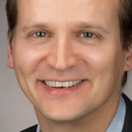

Jonas Korlach is being honored as a Champion of Change for his accomplishments as an immigrant entrepreneur and innovator.
In 1989, at age 16, I walked with my grandmother through the Berlin Wall at the Brandenburg Gate just after it was opened. The sense of freedom and possibility seemed limitless for the first time in my life. While I stayed in my home in East Berlin for a few more years to finish school, earning my B.A. and then M.S. degrees in Biological Sciences from Berlin’s Humboldt University, my interest in developing new methods and technologies for genetic research ultimately drew me to the United States.
The United States is seen around the world as a place where big ideas are welcome, and encouraged. The nation’s academic institutions and government investment in basic research are esteemed across the globe. Coupled with the enterprising drive found in this country, the U.S. is perhaps the most encouraging environment in the world for inventors, innovators, and entrepreneurs.
Ultimately, I was drawn here by the caliber of research within the nation’s university system. After participating in a high school exchange program and a few summer internships, I moved to America in 1997 as a graduate student in Cornell University’s molecular biology Ph.D. program. It was in Ithaca where I met a physics graduate student, Stephen Turner, who was interested in solving the same challenge as I was—how to observe individual enzyme molecules that synthesize DNA, the genetic blueprint of life, in real time. In collaboration with our advisors, we invented a revolutionary DNA sequencing technology, the first in the world capable of capturing real-time movies of the behavior of these minute single molecules, reading the order, or sequence, of the building blocks of DNA in the process.
With the help of many people, the current commercial product of our invention, the PacBio RS II, is a machine that is advancing the understanding of infectious disease, microbiology, agriculture, and complex genetic diseases. Based on the Single Molecule, Real-Time (SMRT) Sequencing technology we invented at Cornell, the product is the capstone of a publicly traded company that now employs nearly 300 people in the U.S. Appropriately based in Silicon Valley, our company employs a wide range of highly specialized scientists and engineers from disciplines including molecular biology, enzymology, surface chemistry, bioinformatics, nanofabrication, and optics, alongside marketing, sales, manufacturing and other staff to support our R&D and commercial operations.
Remaining here hasn’t been without its obstacles—obstacles that many of today’s foreign-born science, technology, engineering, and mathematics (STEM) graduates must overcome. I was fortunate enough to have the support of a U.S. Congresswoman who spoke up on my behalf to help me secure a temporary residency visa in 2004. But what happens to all of the bright foreign students who are not as lucky as I was? Currently, the U.S. is short on so many native-born graduate students pursuing STEM degrees that by 2018, the country is projected to have 230,000 jobs requiring graduate-level STEM training that it will not be able to fill with native-born workers. Encouraging high-skilled workers from around the world to fill these gaps not only helps them realize their dreams, but also helps support the U.S. economy and the nation’s interests in being the innovation capital of the world.
When the Berlin Wall came down, I felt like anything was possible. But it was only here in the United States where those dreams became reality. Since arriving in 1997, I have earned my Ph.D., been granted 33 U.S. patents, and helped build a company that is on the cutting edge of genetic research. In 2011, I was honored to be present as the PacBio RS was installed in a top research institution in Germany, an event that drew the attendance of VIP guest Chancellor Angela Merkel. I stood next to her, an East German herself and a physicist by training, as she insisted on being the first person to start the machine. It was a historic moment in Germany that was in part made possible by a historic moment 22 years before, when a wall came down and opened the possibilities for me to participate in the American Dream. Today I am immensely grateful for the opportunities I have been given in this country, and to be honored as a Champion of Change.
Jonas Korlach is Chief Scientific Officer of Pacific BioSciences.


